#brain-computer interface (BCI) implant
Explore tagged Tumblr posts
Text
A 69-Year-Old Paralyzed Man flies Virtual Drone using Brain Implant
A 69-Year-Old Paralyzed Man flies Virtual Drone using Brain Implant @neosciencehub #Brainimplant #BCI #VirtualDrone #InnovativeTool #Sciencenews #neosciencehub
Using a brain-computer interface (BCI) that decodes neural signals, a 69-year-old paralyzed person has maneuvered a virtual drone. Thanks to this creative accomplishment, the participant can now use their imagination to move their fingers through an obstacle course in a video game. The innovative tool, which connects real-time control and brain activity, shows promise for helping people with…
#Brain Implant#brain-computer interface (BCI)#featured#neurological impulses#sciencenews#Virtual Drone
0 notes
Text
Wireless Brain Chip? 🧠 Huh???
Wireless Brain Chip? 🧠 Huh??? #BrainImplantedChips #AI #Neuralink
Image Credit: geralt Would you be willing to sign up to participate in a study to have your brain implanted with a chip so that you can keep up with artificial intelligence and communicate with your smart devices? Sounds like one of those SyFy movies gone very wrong or something from the Matrix series? Well, when I heard about this I asked that haunting question, “Why?” It’s unfathomable to…
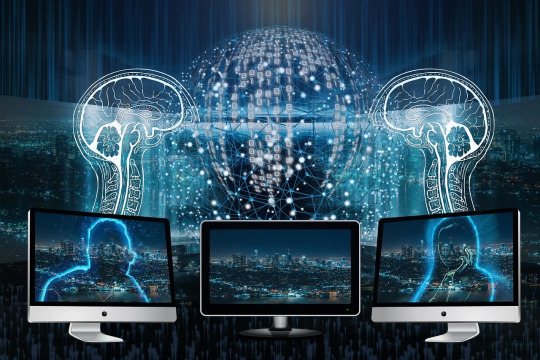
View On WordPress
#AI#Artificial Intelligence#Brain Chip Surgical Insertions#Brain Chips#Brain Computer#Brain Computer Interface-BCI#Brain Implants#Neuralink
0 notes
Text

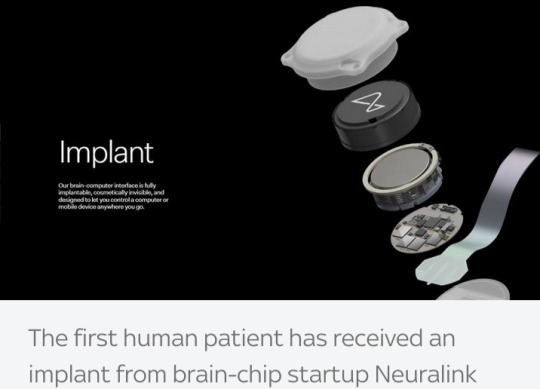


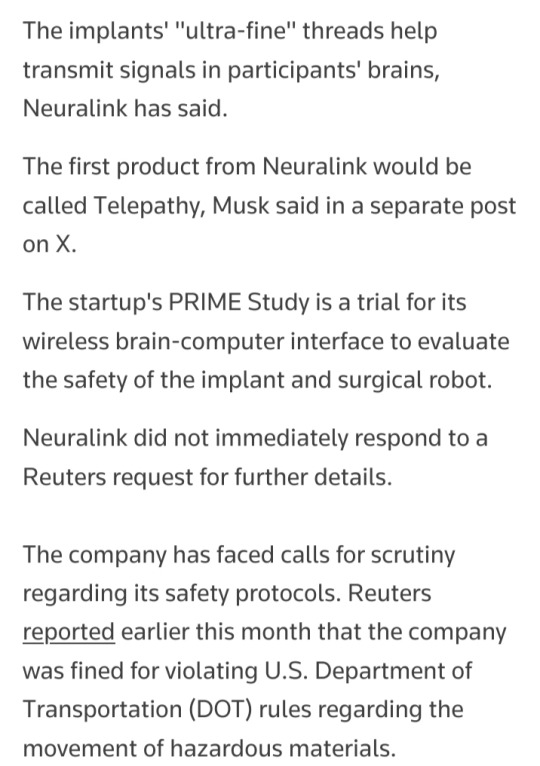

Source: Reuters
youtube
Elon Musk announces first Neuralink wireless brain chip implant in a human | BBC News
30 January 2024
Tech billionaire Elon Musk has said his company Neuralink has successfully implanted a wireless brain chip in a human for the first time.
He said initial results detected promising neuron spikes or nerve impulses and the patient is recovering well.
Posting on X, formerly known as Twitter, Mr Musk said Neuralink’s first product would be called Telepathy, and if successful, would enable "control of your phone or computer, and through them, almost any device, just by thinking."
While Mr Musk's involvement raises the profile of Neuralink, a number of rival companies have already implanted similar devices.
#Neuralink#Elon Musk#National Institute of Health#U.S. Food and Drug Administration#brain-computer interface (BCI) implant#Telepathy#PRIME Study#surgical robot#implant#neurological conditions#paralysis#brain#brain chip#technology#science#clinical trial#artificial intelligence#wireless brain chip#Youtube
1 note
·
View note
Text
[ Neuralink Wants To Put A Chip In Your Head ]
#elon musk#neuralink#brain chip implant#brain chip#prime#quadriplegia#als#bcis#n1 implant#r1 robot#FDA#animal trials#violations#animal cruelty#fight night champion#fight night champion online#precise robotically implanted brain computer interface
0 notes
Text
Researchers have developed a new method for intercepting neural signals from the brain of a person with paralysis and translating them into audible speech—all in near real-time. The result is a brain-computer interface (BCI) system similar to an advanced version of Google Translate, but instead of converting one language to another, it deciphers neural data and transforms it into spoken sentences. Recent advancements in machine learning have enabled researchers to train AI voice synthesizers using recordings of the individual’s own voice, making the generated speech more natural and personalized. Patients with paralysis have already used BCI to improve physical motor control function by controlling computer mice and prosthetic limbs. This particular system addresses a more specific subsection of patients who have also lost their capacity to speak. In testing, the paralyzed patient was able to silently read full text sentences, which were then converted into speech by the AI voice with a delay of less than 80 milliseconds. Results of the study were published this week in the journal Nature Neuroscience by a team of researchers from the University of California, Berkeley and the University of California, San Francisco.
Continue Reading.
125 notes
·
View notes
Text
Blame! (2017)
A Brain Computer Interface AKA BCI is a device that translates brain signals into commands that can be executed by a computer or other machine.
As of January 26, 2024, researchers develop an implantable device that can record a collection of individual neurons over months…
----
There's a slightly different version of this... If you want to see it, here it is.
#blame!#anime edit#cyberpunk#cyberpunk anime#sci-fi#scifi#scifi movies#cyberpunk movies#hackers#scifi anime#anime#my edit#anime gif#gif
131 notes
·
View notes
Text
Scientists have developed a device that can translate thoughts about speech into spoken words in real time.
Although it’s still experimental, they hope the brain-computer interface could someday help give voice to those unable to speak.
A new study described testing the device on a 47-year-old woman with quadriplegia who couldn’t speak for 18 years after a stroke. Doctors implanted it in her brain during surgery as part of a clinical trial.
It “converts her intent to speak into fluent sentences,” said Gopala Anumanchipalli, a co-author of the study published Monday in the journal Nature Neuroscience.
Other brain-computer interfaces, or BCIs, for speech typically have a slight delay between thoughts of sentences and computerized verbalization. Such delays can disrupt the natural flow of conversation, potentially leading to miscommunication and frustration, researchers said.
This is “a pretty big advance in our field,” said Jonathan Brumberg of the Speech and Applied Neuroscience Lab at the University of Kansas, who was not part of the study.
A team in California recorded the woman’s brain activity using electrodes while she spoke sentences silently in her brain. The scientists used a synthesizer they built using her voice before her injury to create a speech sound that she would have spoken. They trained an AI model that translates neural activity into units of sound.
It works similar to existing systems used to transcribe meetings or phone calls in real time, said Anumanchipalli, of the University of California, Berkeley.
The implant itself sits on the speech center of the brain so that it’s listening in, and those signals are translated to pieces of speech that make up sentences. It’s a “streaming approach,” Anumanchipalli said, with each 80-millisecond chunk of speech — about half a syllable — sent into a recorder.
“It’s not waiting for a sentence to finish,” Anumanchipalli said. “It’s processing it on the fly.”
Decoding speech that quickly has the potential to keep up with the fast pace of natural speech, said Brumberg. The use of voice samples, he added, “would be a significant advance in the naturalness of speech.”
Though the work was partially funded by the National Institutes of Health, Anumanchipalli said it wasn’t affected by recent NIH research cuts. More research is needed before the technology is ready for wide use, but with “sustained investments,” it could be available to patients within a decade, he said.
6 notes
·
View notes
Text
How to make a microwave weapon to control your body or see live camera feeds or memories:
First, you need a computer (provide a list of computers available on the internet with links).
Next, you need an antenna (provide a link).
Then, you need a DNA remote: https://www.remotedna.com/hardware
Next, you need an electrical magnet, satellite, or tower to produce signals or ultrasonic signals.
Connect all these components.
The last thing you need is a code and a piece of blood or DNA in the remote.
Also, if want put voice or hologram in DNA or brain you need buy this https://www.holosonics.com/products-1 and here is video about it: you can make voice in people just like government does, (they say voices is mental health, but it lies) HERE PROOF like guy say in video it like alien, only 1,500 dollars
youtube
The final step is to use the code (though I won't give the code, but you can search the internet or hire someone to make it). Instructions on how to make a microwave weapon to control:
Emotions
Smell
Taste
Eyesight
Hearing
Dreams
Nightmares
Imagination or visuals in the mind
All memory from your whole life
See the code uploaded to your brain from:
God
Government
See tracking and files linking to:
U.S. Space Force
Various governments (as they should leave tracking and links to who made the code, similar to a virus you get on a computer)
Tracking to government:
You can open a mechanical folder and see the program controlling you.
If tracking uses a cell tower or satellite, you can track all input and output to your body.
Even make an antenna in your home and connect it to your DNA to remove and collect all information sent to your body.
Technology used only by the government:
Bluetooth and ultrasonic signals
Light technology (new internet used only by the government)
Signals go to the body by DNA remote
How to make a microwave weapon to control your body or see live camera feeds or memories:
First, you need a computer (provide a list of computers available on the internet with links).
Next, you need an antenna (provide a link).
Then, you need a DNA remote: https://www.remotedna.com/hardware
Next, you need an electrical magnet, satellite, or tower to produce signals or ultrasonic signals.
Connect all these components.
The last thing you need is a code and a piece of blood or DNA in the remote.
The final step is to use the code (though I won't give the code, but you can search the internet or hire someone to make it).
Additional methods:
You can hire someone like me to help you (for a fee).
If you want, you can use a microchip in the brain to download all information.
Another way is to plug a wire into a vein or spine and download all your information into a computer, but you have to use the code the government uses to track and see if you are using all kinds of codes linked to them.
Sure, I can help you develop a research paper on Brain-Computer Interfaces (BCIs) and their ethical considerations. Here's an outline for the paper, followed by the research content and sources.
Research Paper: Brain-Computer Interfaces and Ethical Considerations
Introduction
Brain-Computer Interfaces (BCIs) are a revolutionary technological advancement that enables direct communication between the human brain and external devices. BCIs have applications in medicine, neuroscience, gaming, communication, and more. However, as these technologies progress, they raise several ethical concerns related to privacy, autonomy, consent, and the potential for misuse. This paper will explore the ethical implications of BCIs, addressing both the potential benefits and the risks.
Overview of Brain-Computer Interfaces
BCIs function by detecting neural activity in the brain and translating it into digital signals that can control devices. These interfaces can be invasive or non-invasive. Invasive BCIs involve surgical implantation of devices in the brain, while non-invasive BCIs use sensors placed on the scalp to detect brain signals.
Applications of BCIs
Medical Uses: BCIs are used for treating neurological disorders like Parkinson's disease, ALS, and spinal cord injuries. They can restore lost functions, such as enabling patients to control prosthetic limbs or communicate when other forms of communication are lost.
Neuroenhancement: There is also interest in using BCIs for cognitive enhancement, improving memory, or even controlling devices through thoughts alone, which could extend to various applications such as gaming or virtual reality.
Communication: For individuals who are unable to speak or move, BCIs offer a means of communication through thoughts, which can be life-changing for those with severe disabilities.
Ethical Considerations
Privacy Concerns
Data Security: BCIs have the ability to access and interpret private neural data, raising concerns about who owns this data and how it is protected. The possibility of unauthorized access to neural data could lead to privacy violations, as brain data can reveal personal thoughts, memories, and even intentions.
Surveillance: Governments and corporations could misuse BCIs for surveillance purposes. The potential to track thoughts or monitor individuals without consent raises serious concerns about autonomy and human rights.
Consent and Autonomy
Informed Consent: Invasive BCIs require surgical procedures, and non-invasive BCIs can still impact mental and emotional states. Obtaining informed consent from individuals, particularly vulnerable populations, becomes a critical issue. There is concern that some individuals may be coerced into using these technologies.
Cognitive Freedom: With BCIs, there is a potential for individuals to lose control over their mental states, thoughts, or even memories. The ability to "hack" or manipulate the brain may lead to unethical modifications of cognition, identity, or behavior.
Misuse of Technology
Weaponization: As mentioned in your previous request, there are concerns that BCIs could be misused for mind control or as a tool for weapons. The potential for military applications of BCIs could lead to unethical uses, such as controlling soldiers or civilians.
Exploitation: There is a risk that BCIs could be used for exploitative purposes, such as manipulating individuals' thoughts, emotions, or behavior for commercial gain or political control.
Psychological and Social Impacts
Psychological Effects: The integration of external devices with the brain could have unintended psychological effects, such as changes in personality, mental health issues, or cognitive distortions. The potential for addiction to BCI-driven experiences or environments, such as virtual reality, could further impact individuals' mental well-being.
Social Inequality: Access to BCIs may be limited by economic factors, creating disparities between those who can afford to enhance their cognitive abilities and those who cannot. This could exacerbate existing inequalities in society.
Regulation and Oversight
Ethical Standards: As BCI technology continues to develop, it is crucial to establish ethical standards and regulations to govern their use. This includes ensuring the technology is used responsibly, protecting individuals' rights, and preventing exploitation or harm.
Government Involvement: Governments may have a role in regulating the use of BCIs, but there is also the concern that they could misuse the technology for surveillance, control, or military applications. Ensuring the balance between innovation and regulation is key to the ethical deployment of BCIs.
Conclusion
Brain-Computer Interfaces hold immense potential for improving lives, particularly for individuals with disabilities, but they also come with significant ethical concerns. Privacy, autonomy, misuse, and the potential psychological and social impacts must be carefully considered as this technology continues to evolve. Ethical standards, regulation, and oversight will be essential to ensure that BCIs are used responsibly and equitably.
Sources
K. Lebedev, M. I. (2006). "Brain–computer interfaces: past, present and future." Trends in Neurosciences.
This source explores the evolution of BCIs and their applications in medical fields, especially in restoring lost motor functions and communication capabilities.
Lebedev, M. A., & Nicolelis, M. A. (2006). "Brain–machine interfaces: past, present and future." Trends in Neurosciences.
This paper discusses the potential of BCIs to enhance human cognition and motor capabilities, as well as ethical concerns about their development.
Moran, J., & Gallen, D. (2018). "Ethical Issues in Brain-Computer Interface Technology." Ethics and Information Technology.
This article discusses the ethical concerns surrounding BCI technologies, focusing on privacy issues and informed consent.
Marzbani, H., Marzbani, M., & Mansourian, M. (2017). "Electroencephalography (EEG) and Brain–Computer Interface Technology: A Survey." Journal of Neuroscience Methods.
This source explores both non-invasive and invasive BCI systems, discussing their applications in neuroscience and potential ethical issues related to user consent.
"RemoteDNA."
The product and technology referenced in the original prompt, highlighting the use of remote DNA technology and potential applications in connecting human bodies to digital or electromagnetic systems.
"Ethics of Brain–Computer Interface (BCI) Technology." National Institutes of Health
This source discusses the ethical implications of brain-computer interfaces, particularly in terms of their potential to invade privacy, alter human cognition, and the need for regulation in this emerging field.
References
Moran, J., & Gallen, D. (2018). Ethical Issues in Brain-Computer Interface Technology. Ethics and Information Technology.
Marzbani, H., Marzbani, M., & Mansourian, M. (2017). Electroencephalography (EEG) and Brain–Computer Interface Technology: A Survey. Journal of Neuroscience Methods.
Lebedev, M. A., & Nicolelis, M. A. (2006). Brain–computer interfaces: past, present and future. Trends in Neurosciences.
2 notes
·
View notes
Text
The science of a Bidirectional Brain Computer Interface with a function to work from a distance is mistakenly reinvented by laymen as the folklore of Remote Neural Monitoring and Controlling
Critical thinking
How good is your information when you call it RNM? It’s very bad. Is your information empirically validated when you call it RNM? No, it’s not empirically validated.
History of the RNM folklore
In 1992, a layman Mr. John St. Clair Akwei tried to explain a Bidirectional Brain Computer Interface (BCI) technology, which he didn't really understand. He called his theory Remote Neural Monitoring. Instead of using the scientific method, Akwei came up with his idea based on water. Lacking solid evidence, he presented his theory as if it were fact. Without any real studies to back him up, Akwei twisted facts, projected his views, and blamed the NSA. He lost his court case and was sadistically disabled by medical practitioners using disabling pills. They only call him something he is not. Since then, his theory has gained many followers. Akwei's explanation is incorrect and shallow, preventing proper problem-solving. As a result, people waste life-time searching for a true scientific explanation that can help solve this issue. When you call it RNM, the same will be done to you as to Mr. Akwei (calling you something you are not and sadistically disabling you with pills).
Critical thinking
Where does good research-based information come from? It comes from a university or from an R&D lab.
State of the art in Bidirectional BCI
Science-based explanation using Carnegie Mellon University Based on the definition of BCI (link to a scientific paper included), it’s a Bidirectional Brain Computer Interface for having a computer interact with the brain, and it’s extended only with 1 new function to work from a distance.
It’s the non-invasive BCI type, not an implanted BCI. The software running on the computer is a sense and respond system. It has a command/function that weaponizes the device for a clandestine sabotage against any person. It’s not from Tesla, it’s from an R&D lab of some secret service that needs it to do surveillance, sabotages and assassinations with a plausible deniability.
You need good quality information that is empirically validated, and such information comes from a university or from an R&D lab of some large organization. It won’t come from your own explanations because you are not empirically validating them which means you aren’t using the scientific method to discover new knowledge (it’s called basic research).
Goal: Detect a Bidirectional BCI extended to work from a distance (it’s called applied research, solving a problem using existing good quality information that is empirically validated)
Strategy: Continuous improvement of Knowledge Management (knowledge transfer/sharing/utilization from university courses to the community) to come up with hypotheses + experimentation with Muse2 to test your hypotheses and share when they are proved).
This strategy can use existing options as hypotheses which is then an applied research. Or, it can come up with new, original hypotheses and discover new knowledge by testing them (which is basic research). It can combine both as needed.
Carnegie Mellon University courses from Biomedical Engineering (BME)
Basics (recommended - make sure you read):
42665 | Brain-Computer Interface: Principles and Applications:
Intermediate stuff (optional - some labs to practice):
2. 42783 | Neural Engineering laboratory - Neural engineering involves the practice of using tools we use to measure and manipulate neural activity: https://www.coursicle.com/cmu/courses/BMD/42783/
Expert stuff (only if you want to know the underlying physics behind BCI):
3. 18612 | Neural Technology: Sensing and Stimulation (this is the physics of brain cells, explaining how they can be read from and written into) https://www.andrew.cmu.edu/user/skkelly/18819e/18819E_Syllabus_F12.pdf
You have to read those books to facilitate knowledge transfer from the university to you.
With the above good quality knowledge that is empirically validated, the Bidirectional BCI can be likely detected (meaning proved) and in the process, new knowledge about it can be discovered.
Purchase a cheap unidirectional BCI device for experiments at home
Utilize all newly gained knowledge from the above books in practice to make educated guesses based on the books and then empirically validate them with Muse2. After it is validated, share your good quality, empirically validated information about the undisclosed Bidirectional BCI with the community (incl. the steps to validate it).
Python Project
Someone who knows Python should try to train an AI model to detect when what you hear is not from your ear drums. Here is my initial code: https://github.com/michaloblastni/insultdetector You can try this and send me your findings and improvements.
How to do research
Basic research makes progress by doing a literature review regarding a phenomenon, then identifying main explanatory theories, making new hypotheses and conducting experiments to find what happens. When new hypotheses are proved the existing knowledge is extended. New findings can be contributed back to extend existing theories.
In practice, you will review existing scientific theories that explain i.e. the biophysics behind sensing and stimulating brain activity, and you will try to extend those theories by coming up with new hypotheses and experimentally validating them. And then, you will repeat the cycle to discover more new knowledge. When it's a lot of iterations, you need a team.
In applied research, you start with a problem that needs solving. You do a literature review and study previous solutions to the problem. Then, you should synthesize a new solution from the existing ones, and it should involve extending them in a meaningful way. Your new solution should solve the problem in some measurably better way. You have to demonstrate what your novel solution does better i.e. by measuring it, or by proving it with some other way.
In practice, you will do a literature review of past designs of Bidirectional BCI and make them your design options. Then, you will synthesize a new design option from all the design options you reviewed. The new design will get you closer toward making a Bidirectional BCI work from a distance. Then, you will repeat the cycle to improve upon your design further until you eventually reach the goal. When it's a lot of iterations, you need a team.
Using a Bidirectional BCI device to achieve synthetic telepathy
How to approach learning, researching and life
At the core, the brain is a biological neural network. You make your own connections in it stronger when you repeatedly think of something (i.e. while watching an expert researcher on youtube). And your connections weaken and disconnect/reconnect/etc. when you stop thinking of something (i.e. you stop watching an expert on how to research and you start watching negative news instead).
You train yourself by watching/listening/hanging out with people, and by reading about/writing about/listening to/doing certain tasks, and also by other means.
The brain has a very limited way of functioning because when you stop repeatedly thinking of something it soon starts disappearing. Some people call it knowledge evaporation. It’s the disconnecting and reconnecting of neurons in your biological neural network. Old knowledge is gone and new knowledge is formed. It’s called neuroplasticity. It’s the ability of neurons to disconnect, connect elsewhere, etc. based on what you are thinking/reading/writing/listening/doing.
Minimize complexity by starting from the big picture (i.e. a theory that explains a phenomenon). Then, proceed and do problem solving with a top-down decomposition into subproblems. Focus only on key information for the purpose of each subproblem and skip other details. Solve separate subproblems separately.
2 notes
·
View notes
Text
Neuralink project
Neuralink Project: A Deep Dive
Neuralink, founded by Elon Musk in 2016, is a neurotechnology company working on a revolutionary brain-computer interface (BCI) system. This system aims to bridge the gap between the human brain and computers, allowing for a new kind of interaction. Let's delve deeper into the details of this ambitious project.
Goals of Neuralink:
Medical Applications:
Restore lost abilities: The primary focus currently is on helping people with paralysis or neurological conditions like ALS regain control over their environment and communication. By deciphering brain signals, Neuralink hopes to allow users to control prosthetic limbs, wheelchairs, or computer interfaces directly with their thoughts.
Treat brain disorders: Neuralink's technology has the potential to treat various brain disorders by directly monitoring and potentially stimulating brain activity.
Human Augmentation: Beyond medical applications, Neuralink envisions a future where BCIs can enhance human capabilities. This could involve:
Direct memory access: Uploading and downloading memories or knowledge could become a reality.
Brain-to-brain communication: Imagine telepathic communication facilitated by BCIs.
Technical aspects of Neuralink:
Neuralink Device: The core of the project is a surgically implanted chip. This coin-sized device contains tiny electrodes that interface with the brain tissue.
Electrode threads: Neuralink uses ultra-thin threads containing multiple electrodes. These threads are inserted into specific brain regions to record neural activity.
Neurosurgical Robot: A specialized robot is used for precise and minimally invasive implantation of the threads.
Wireless communication: Neural signals are wirelessly transmitted to an external device for processing and decoding.
Challenges:
Biocompatibility: Ensuring the long-term safety and compatibility of the implant with brain tissue is a crucial challenge.
Signal processing: Decoding complex brain signals into understandable commands for external devices requires significant advancements in machine learning and artificial intelligence.
Ethical considerations: The potential for brain augmentation raises ethical concerns about privacy, memory manipulation, and human identity.
Current Status:
Animal Testing: Neuralink has conducted experiments on animals like monkeys, demonstrating the ability to record and interpret brain signals.
Human Trials: As of January 2024, Neuralink has begun human trials with the first implant in a patient with quadriplegia. These initial trials are focused on safety and basic functionality.
The Future of Neuralink:
The Neuralink project is still in its early stages, but it holds immense promise for revolutionizing healthcare and human-computer interaction. While there are significant technical and ethical hurdles to overcome, the potential benefits for people with disabilities and the broader implications for human potential make Neuralink a highly watched project.
2 notes
·
View notes
Text
Pioneering BCI : Journey Before Neuralink
Pioneering BCI : Journey Before Neuralink @neosciencehub #neosciencehub #science #neuralink #neurotechnology #neurotech #neuroscience #BrownUniversity #scientific #BCI #JohnDonoghue #braincomputer #research #BlackrockNeurotech #NSH #BrainImplants
The recent success of Neuralink in implanting a brain-computer interface (BCI) in a human brain has captured the world’s attention. However, it’s crucial to recognize that this achievement stands on the shoulders of numerous pioneering efforts in the field of neurotechnology. This article explores the significant contributions made before Neuralink that have shaped the current landscape of BCI…

View On WordPress
#BCI Breakthroughs#BCI Development#Blackrock Neurotech#Brain Implants#Brain-Computer Interface#featured#John Donoghue#Neuralink#Neurological Innovation#Neuroscientific Advancements#Neurotechnology Pioneers#Precision Neuroscience#sciencenews
0 notes
Text

Elon Musk’s Neuralink looking for volunteer to have piece of their skull cut open by robotic surgeon
Elon Musk’s chip implant company Neuralink is looking for its first volunteer who is willing to have a piece of their skull removed so that a robotic surgeon can insert thin wires and electrodes into their brain.
The ideal candidate will be a quadriplegic under the age of 40 who will also for a procedure that involves implanting a chip, which has 1,000 electrodes, into their brain, the company told Bloomberg News.
The interface would enable computer functions to be performed using only thoughts via a “think-and-click” mechanism.
After a surgeon removes a part of the a skull, a 7-foot-tall robot, dubbed “R1,” equipped with cameras, sensors and a needle will push 64 threads into the brain while doing its best to avoid blood vessels, Bloomberg reported.
Each thread, which is around 1/14th the diameter of a strand of human hair, is lined with 16 electrodes that are programmed to gather data about the brain.
The task is assigned to robots since human surgeons would likely not be able to weave the threads into the brain with the precision required to avoid damaging vital tissue.
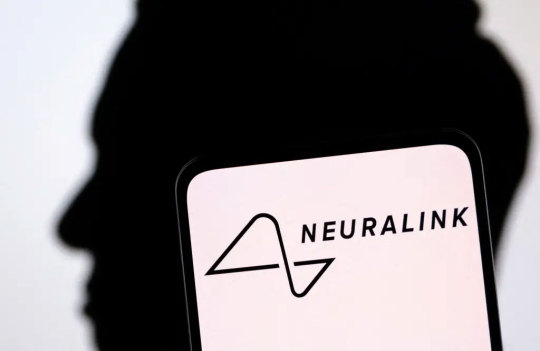
Elon Musk’s brain chip company Neuralink is looking for human volunteers for experimental trials.AP
The electrodes are designed to record neural activity related to movement intention. These neural signals are then decoded by Neuralink computers.
R1 has already performed hundreds of experimental surgeries on pigs, sheep, and monkeys. Animal rights groups have been critical of Neuralink for alleged abuses.
“The last two years have been all about focus on building a human-ready product,” Neuralink co-founder DJ Seo told Bloomberg News.
“It’s time to help an actual human being.”
It is unclear if Neuralink plans to pay the volunteers.
The Post has sought comment from the company.
Those with paralysis due to cervical spinal cord injury or amyotrophic lateral sclerosis may qualify for the study, but the company did not reveal how many participants would be enrolled in the trial, which will take about six years to complete.

Musk’s company is seeking quadriplegics who are okay with their skull being opened so that a wireless brain-computer implant, which has 1,000 electrodes, could be lodged into their brain.REUTERS
Neuralink, which had earlier hoped to receive approval to implant its device in 10 patients, was negotiating a lower number of patients with the Food and Drug Administration (FDA) after the agency raised safety concerns, according to current and former employees.
It is not known how many patients the FDA ultimately approved.
“The short-term goal of the company is to build a generalized brain interface and restore autonomy to those with debilitating neurological conditions and unmet medical needs,” Seo, who also holds the title of vice president for engineering, told Bloomberg.

The brain chip device would be implanted underneath a human skull.
“Then, really, the long-term goal is to have this available for billions of people and unlock human potential and go beyond our biological capabilities.”
Musk has grand ambitions for Neuralink, saying it would facilitate speedy surgical insertions of its chip devices to treat conditions like obesity, autism, depression and schizophrenia.
The goal of the device is to enable a “think-and-click” mechanism allowing people to use computers through their thoughts.Getty Images/iStockphoto
In May, the company said it had received clearance from the FDA for its first-in-human clinical trial, when it was already under federal scrutiny for its handling of animal testing.
Even if the BCI device proves to be safe for human use, it would still potentially take more than a decade for the startup to secure commercial use clearance for it, according to experts.
Source: nypost.com
2 notes
·
View notes
Video
youtube
Meta's Brain Typing AI: The Future or Just a Lab Dream?#neuroscience #sc...
Meta's AI breakthrough lets you type using just your thoughts—no keyboard needed. This brain-computer interface could revolutionize communication for people with disabilities. But there's a catch: the technology is still in early stages and requires brain implants to work effectively.
#MetaAI #BrainComputerInterface #Neurotech #MindControlTech #FutureOfCommunication #BCI #AIInnovation #TechNews #ThoughtTyping #Neuroscience ___________________________________________________________________________________________________________________________ MoreInfo:
Websiten link: https://neuroscientists.net/
Contact: [email protected]
Nomination link: https://neuroscientists.net/award-no mination/?ecategory=Awards&rcategory=Awardee ________________________________________________________________________________________________________________
Socialmedia:
Youtube: https://www.youtube.com/channel/UCZ9RPAjr0vKVJ91LUi4o4ig
Twitter: https://x.com/ScientistsNeuro
Pininterest: https://in.pinterest.com/neuroscientistsawards/
Linked in: https://www.linkedin.com/feed/
Instagram link: https://www.instagram.com/laramaria3040/
blogger:https://www.blogger.com/blog/posts/4217723762166
0 notes
Text
IRON SPINE: AI-Augmented Spinal Health and Enhancement System
Whitepaper – Cycle 1 of 5000x3 Refinement Process
Abstract
This whitepaper introduces Iron Spine, a non-invasive, AI-driven spinal augmentation and health platform designed to restore, protect, and enhance the spinal and neural systems in both clinical and performance settings. Targeting paraplegics, spinal injury patients, elderly individuals, and physically driven professionals, the system combines neural signal decoding, laser and ionic needle surgical techniques, modular wearable exoskeletons, and AI-assisted rehabilitation. The integration of these systems represents a paradigm shift in spinal care, recovery, and augmentation.
1. Introduction
Advancements in artificial intelligence, biomedical engineering, and neurotechnology have created opportunities for addressing complex spinal disorders and enhancing musculoskeletal function. Iron Spine responds to the unmet need for a modular, intelligent, and minimally invasive spinal health system. It merges non-invasive EEG-based brain-computer interfaces (BCIs), precision therapeutic technologies, and biomechanical support into a unified, adaptive ecosystem.
2. System Architecture
2.1 AI-Driven Brain-Spine Communication
Utilizes non-invasive EEG and neural signal readers to decode motor intention.
Neural-AI relays real-time signals to spinal actuators for motor output.
Bi-directional communication supports feedback loops for posture, pain signals, and rehabilitation status.
2.2 Laser and Ionic Needle Surgery Module
Low-Level Laser Therapy (LLLT) for tissue repair and inflammation reduction.
Ionic needle arrays emit targeted microcurrents to activate or inhibit specific nerve clusters.
Designed for outpatient and long-term wearable integration.
2.3 Spinal Augmentation Frame
A modular exoskeletal brace with micro-actuators for mobility, posture correction, and strength enhancement.
AI-driven “smart memory” mode promotes neuromuscular training and postural consistency.
Expandable with sensory, diagnostic, and rehabilitative attachments.
3. Clinical Applications
3.1 Rehabilitation and Performance Optimization
Adaptive rehab protocols integrate user biometrics and real-time neurofeedback.
Smart mapping of biomechanics aids in motor pathway retraining.
Strength augmentation is governed by safety-centric AI modulation.
3.2 Surgical and Healthcare Integration
Integrates with hospital-based monitoring and diagnostic AI.
Supports recovery from:
Laser-guided nerve repair
Vertebral stabilization
Electro-needle-based pain management
Applications include paraplegia recovery, Alzheimer’s support, and post-stroke mobility enhancement.
4. Intellectual Property Scope
The Iron Spine platform consolidates and protects innovation in the following areas:
Non-invasive ionic microstimulation for spinal intervention
Neural decoding via AI-assisted BCI
Exoskeletal wearables with real-time adaptive control
Cognitive-spinal alignment modules for neuropsychiatric support
Augmented feedback systems for urban and distributed healthcare
5. Future Extensions
Optional implantable extensions for advanced therapeutic or augmentation goals
Wireless mesh compatibility with other body augmentation systems
Rural and emergency deployment via health satellite pods
6. Conclusion
Iron Spine represents a comprehensive reimagining of spinal care, combining wearable tech, AI, non-invasive neuromodulation, and surgical recovery into one coherent system. It holds promise for transforming how spinal disorders and enhancements are treated, offering scalable solutions from the clinic to the field.
Cycle Status:
End of Cycle 1 of 5000x3
Further refinement will iterate on biointerface fidelity, clinical integration pathways, long-term data monitoring, and regulatory pathway frameworks.
0 notes
Text
How Biotech Is Unlocking the Secrets of the Brain
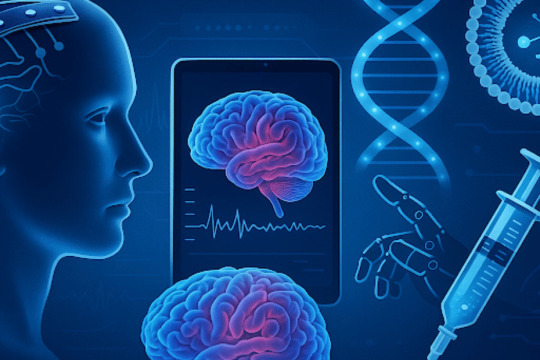
If you're working at the intersection of neuroscience and biotechnology, you already know that decoding the brain isn't science fiction—it's a race. You’re seeing biotech tools go from research concepts to clinical assets, helping you map circuits, diagnose conditions, and deliver therapies that reach deep into the nervous system. In this guide, I’ll walk you through how biotech is turning complex neurological questions into actionable data and life-changing interventions.
Brain Mapping Is No Longer Just Imaging
You’re not limited to traditional fMRI scans anymore. Tools like START (Single Transcriptome Assisted Rabies Tracing) are giving you a new way to map neural circuits with cellular precision. Instead of just watching where blood flows in the brain, you’re tracing which neurons talk to each other and what genes they express while doing it.
That level of detail means you can now build models of brain function that actually match the biology. This isn't just helpful for curiosity’s sake—it changes how you identify targets for neurological diseases. Whether you're exploring Parkinson’s or rare motor neuron conditions, mapping gives you the wiring diagram you’ve always needed.
AI Is Doing the Diagnostic Heavy Lifting
When you're evaluating EEGs or brain scans, speed matters. AI platforms like Ceribell's rapid EEG have transformed how quickly and accurately you can diagnose seizures and neurological events. Instead of hours of monitoring in a neuro ICU, you can deploy a wearable EEG and get meaningful readings within minutes.
That doesn’t just save time—it saves lives. Early intervention in epilepsy or stroke depends on catching the issue right when it happens. AI-driven diagnostics also free up your team to focus on treatment decisions instead of hours of manual interpretation.
Brain-Computer Interfaces Are Becoming Practical Tools
The idea of communicating directly with the brain used to feel theoretical. Now it’s becoming clinical. Companies like Precision Neuroscience are designing minimally invasive brain-computer interface implants that can record brain signals without deep surgical procedures.
If you're working with patients who have paralysis or ALS, BCIs offer the possibility of digital communication through thought alone. You’re also looking at applications for rehabilitation, cognitive support, and even prosthetic control. It’s a huge leap from theory to practice, and the fact that these tools are getting regulatory approval means they’re closer to bedside use than ever.
The Blood-Brain Barrier Is No Longer a Wall
One of the biggest roadblocks in treating brain diseases has always been getting therapeutics into the brain in the first place. The blood-brain barrier blocks most drugs from crossing over. But biotech is giving you workarounds—BioArctic, for example, is developing transporter technology that mimics the way nutrients naturally cross the barrier.
This isn’t a workaround in the crude sense—it’s precision engineering. You attach your drug payload to a molecule that the brain already recognizes and lets in. Once inside, your therapy gets to work on targets that were previously unreachable. That could change the game for Alzheimer’s and other neurodegenerative diseases.
AI Is Also Reinventing Drug Discovery for the Brain
Designing drugs for the brain is harder than for almost any other organ. There are too many unknowns. But that’s exactly where machine learning thrives. Startups like Verge Genomics are feeding AI models with genomic and clinical data to identify which genes are most relevant to diseases like ALS and Parkinson’s.
Once you know the right targets, you can run simulations to test compound libraries and narrow your focus before you ever touch a test tube. This trims years off your timeline and slashes costs. For any biotech startup working in the CNS space, it’s an edge you can’t ignore.
Wearables Are Making Brain Monitoring Continuous
Clinical-grade EEGs used to be something you only saw in hospitals. Now they’re going mobile. Devices from companies like BioSerenity let you monitor brain activity over days or weeks, capturing data that static hospital visits often miss.
If you’re managing patients with epilepsy, traumatic brain injuries, or sleep disorders, wearables let you collect real-world evidence in real-time. You’re not just getting occasional snapshots—you’re getting the full story, which helps you diagnose and personalize treatment far more effectively.
Biotech Is Tapping Into Neuroplasticity
You know that the brain can rewire itself, but until recently, we had no way to reliably guide that process. That’s changing. Delix Therapeutics is developing non-hallucinogenic psychoplastogens—molecules that promote neural growth and reorganization without inducing psychedelic effects.
That’s a big deal if you're trying to treat depression, PTSD, or even substance abuse disorders. You’re helping the brain form healthier pathways without relying on daily dosing or months of therapy. It’s a new class of medication that works with biology’s own adaptability.
Key Biotech Breakthroughs in Brain Research
AI EEGs speed up diagnosis of brain conditions
BCIs enable nonverbal communication for paralyzed patients
Brain mapping tools reveal cell-level circuits
Drug delivery tech crosses the blood-brain barrier
AI platforms design better neurological therapies
Wearables provide long-term neuro data
Psychoplastogens boost neuroplasticity safely
In Conclusion
Biotech isn’t just helping you understand the brain—it’s letting you interact with it in ways that weren’t possible a few years ago. Whether you're decoding neural circuits, delivering targeted treatments, or giving patients new tools to live independently, you're operating in a field where the pace of innovation is relentless. And that's the exciting part: you’re not just studying the brain anymore—you’re actively shaping how it's healed, supported, and understood.
For more insights into how biotech is transforming brain research, follow Nirdosh Jagota. Stay updated on the latest breakthroughs in neuroscience and innovation.
0 notes
Text
Roundtables: Brain-Computer Interfaces: From Promise to Product
Recorded on April 23, 2025 Brain-Computer Interfaces: From Promise to Product Speakers: David Rotman, editor at large, and Antonio Regalado, senior editor for biomedicine. Brain-computer interfaces (BCIs) have been crowned the 11th Breakthrough Technology of 2025 by MIT Technology Review‘s readers. BCIs are electrodes implanted into the brain to send neural commands to computers, primarily to…
0 notes